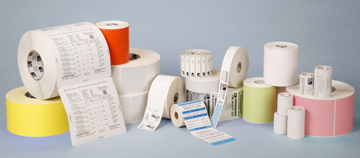Wasp Barcode Technologies: The Barcode Solution People
How to Pick a Barcode Label
Choosing the right barcode label or tag for your application can seem a bit overwhelming. There are many factors that dictate which label or tag will work best for your needs. Fortunately, you can select the right barcode tag or label with just a few pieces of information.

Whether you need basic stock labels, custom labels, or asset tags, knowing a few simple things can make choosing the right label quite easy.
Barcode labels and tags come in all shapes and sizes in a variety of facestocks and adhesives. They can also be custom-made to fit your specific application, even for the most extreme conditions. Whether you need basic stock labels, custom labels, or asset tags, knowing a few simple things can make choosing the right label quite easy.
Which Barcode Printer?
First thing to know: which type of barcode printer are you using? Is it a direct thermal or a thermal transfer printer?
Direct thermal printing uses no ribbon. It uses a specially coated, heat-sensitive paper. That paper turns black when it comes into
direct contact with a heated print head.
Thermal transfer printers use a high-carbon, thermal transfer ribbon. The ribbon passes between the print head and the label. The heat of the print head
transfers the ink from the ribbon to the label. Thermal transfer images are more durable than direct thermal.
Knowing if you need direct thermal or thermal transfer is critical in choosing the right barcode label or tag. The facestocks for each type of printing are specifically coated to work for that type of printing.
Barcode Label or Barcode Tag?
Second thing to know: do you need a label or a tag? No, we’re not being redundant. There is actually a difference!
A barcode label is made up of a facestock, adhesive, and release liner. The back of the facestock is coated with pressure-sensitive adhesive. This allows this media to adhere when you press it down on a surface.
A barcode tag does not have any adhesive or a release liner. It is sometimes referred to as a ticket. A tag will usually have a hang hole.
Paper or Synthetic?
Third thing to know: what type of label material do you need? Paper or synthetic?
Paper is suitable for a wide variety of surfaces and temperature ranges. But it is for indoor applications only. As you can imagine, paper can’t withstand extreme abrasion, moisture, or chemicals, and it does tear easily.
Synthetic labels are more durable than paper. They resist moisture, heat, chemicals, tearing, and outdoor weather.
Within the realm of synthetics, there are many different facestocks. There is polyester, polypropylene, polyolefin, polyimide, and vinyl. Each has different characteristics that make one better for a particular application over the others.
To pick the right synthetic material, there are some additional questions to ask:
- What will the label be adhered to?
- What environmental factors will it be exposed to? This includes abrasion, chemicals, moisture, weather, and extreme temperatures.
- How long will it need to last?
What Type of Adhesive?
Final thing to know: what type of adhesive do you need? Of course, if you are using a tag, there is no adhesive. But for labels, there are many choices.
The main types of adhesives are permanent, removable, repositionable (ultra-removable), freezer-grade, and patterned.
Permanent adhesive is used when the label is intended to remain on the surface and be difficult to remove.
Removable adhesive is removable, but only once. The adhesive does become stronger the longer it is stuck to a surface. So it can become “permanent” eventually. It is not recommended for porous surfaces. The adhesive tends to “grab onto” those surfaces better and not remove as easily.
Repositionable adhesive can be removed and reapplied to a broad range of surfaces. It is similar to a Post-It-Note. It is not recommended for porous surfaces either.
Freezer-grade adhesives are for use within certain low temperature ranges.
Patterned adhesive means that a certain portion of the label is free from adhesive. This is usually used for jewelry labels. No one likes having gummy adhesive residue on their jewelry.
Specialty Labels
There are also many types of specialty labels made for specific applications.
Tamper evident labels are great when more security is needed. Once the label is applied, it cannot be removed and reapplied. “Void” labels will leave part of the adhesive behind. Destructible vinyl labels will break apart into little pieces.
Jewelry labels come in special shapes that are ideal for labeling small item. There is the dumbbell label, also called a butterfly label. There is also the rattail label.
Self laminating labels are also called cable labels. They are used mainly to label cables. They have a white printable area and a longer clear area that wraps around the cable and the printed area. This helps it stick better and protects the print.
There are also opaque, piggyback, retro-reflective, and even aluminum and steel barcode labels.
We hope this helps you to understand the variety of barcode labels and tags a little better. If you have more questions, please post a comment or give us a call. We will help you wade through the wide world of barcode labels.
 Whether you need basic stock labels, custom labels, or asset tags, knowing a few simple things can make choosing the right label quite easy.
Whether you need basic stock labels, custom labels, or asset tags, knowing a few simple things can make choosing the right label quite easy.

